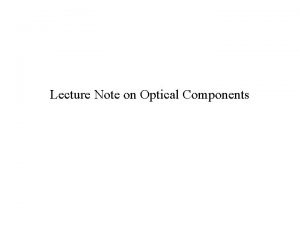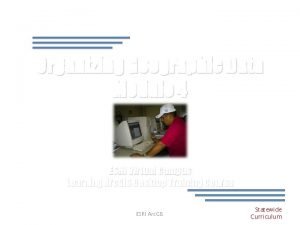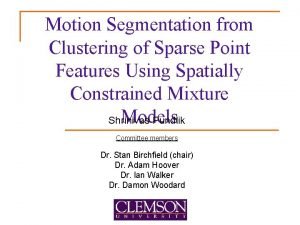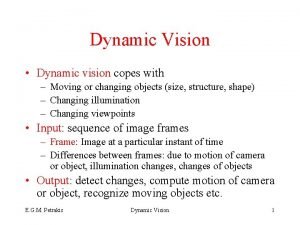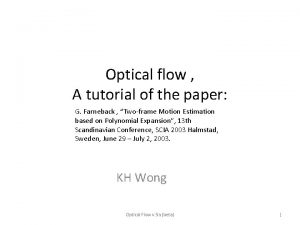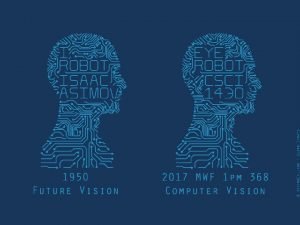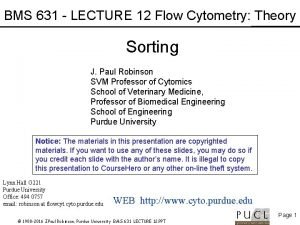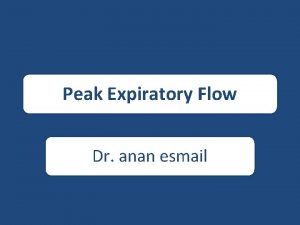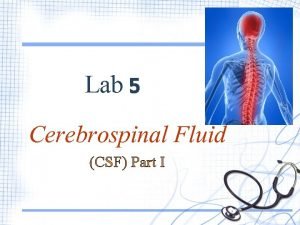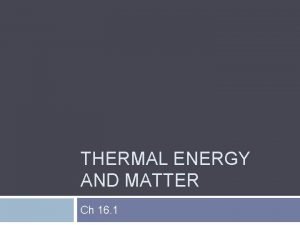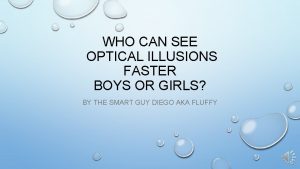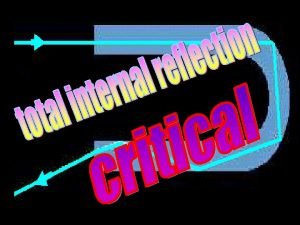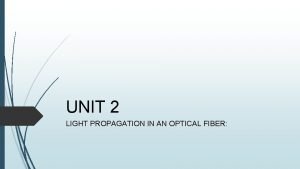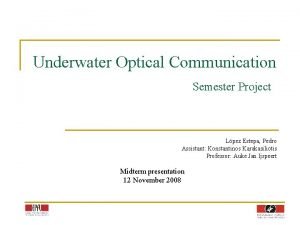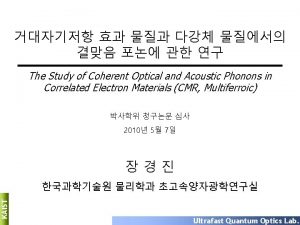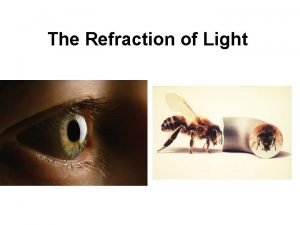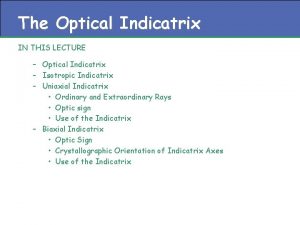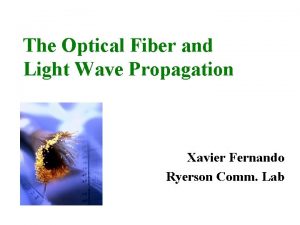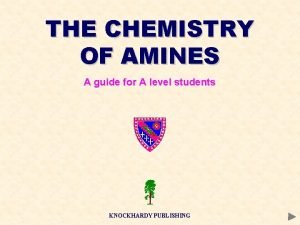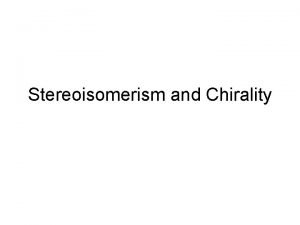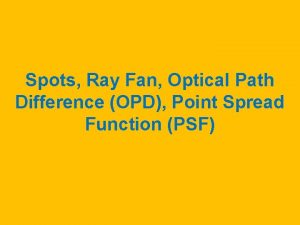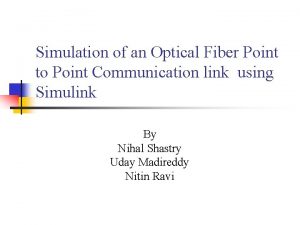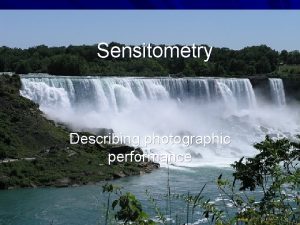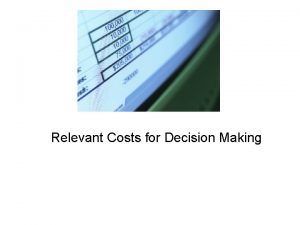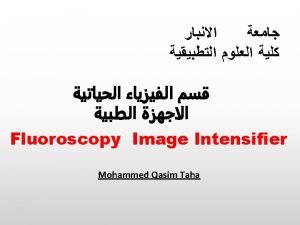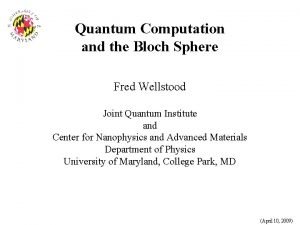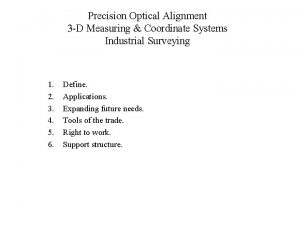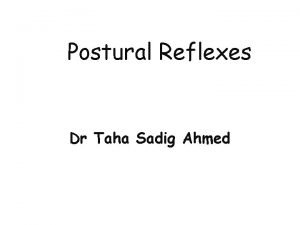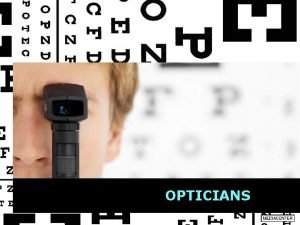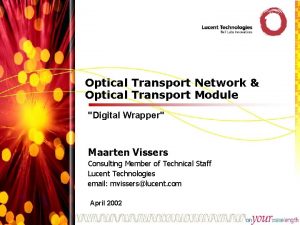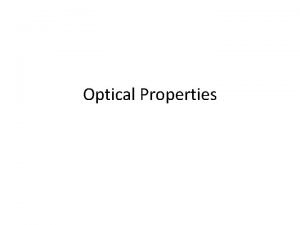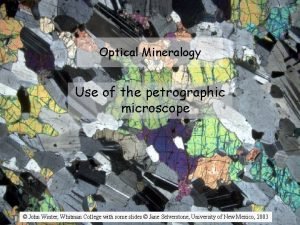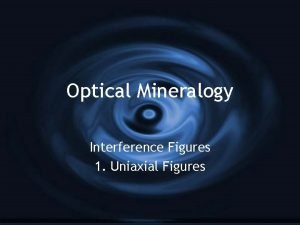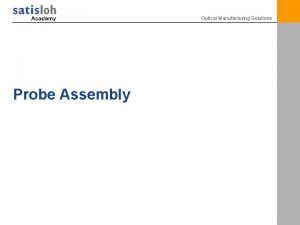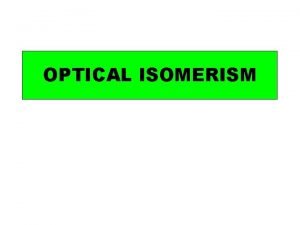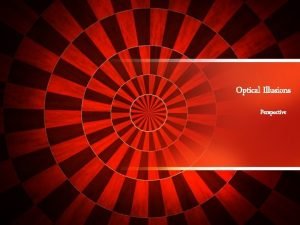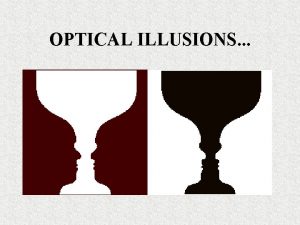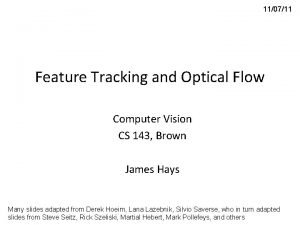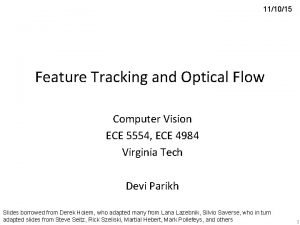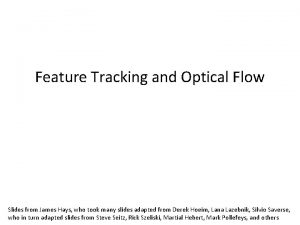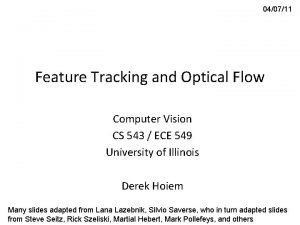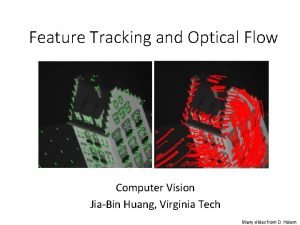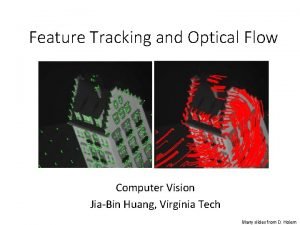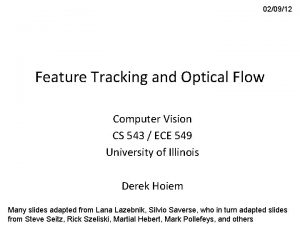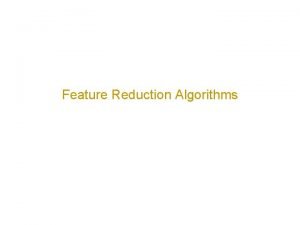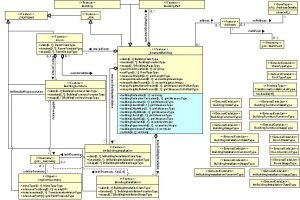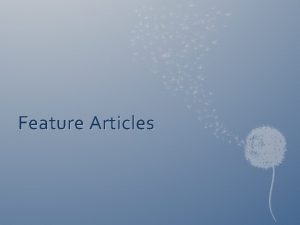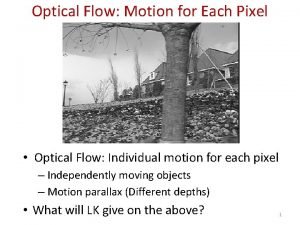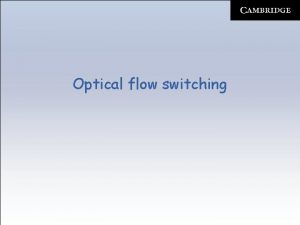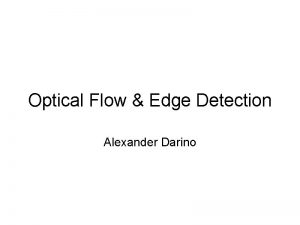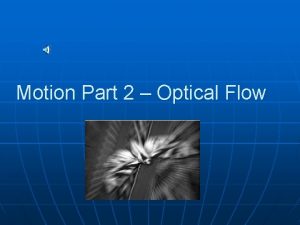Lecture 9 Optical Flow Feature Tracking Normal Flow




























































- Slides: 60

Lecture 9 Optical Flow, Feature Tracking, Normal Flow Gary Bradski Sebastian Thrun * http: //robots. stanford. edu/cs 223 b/index. html 1 * Picture from Khurram Hassan-Shafique CAP 5415 Computer Vision 2003

Q from stereo about Essential Matrix (from Trucco P-153) • Equation of the epipolar plane – Co-planarity condition of vectors Pl, T and Pl-T • Essential Matrix E = RS – 3 x 3 matrix constructed from R and T (extrinsic only) • Rank (E) = 2, two equal nonzero singular values Rank (R) =3 Rank (S) =2 Why is this zero if it’s not orthogonal? 2

Question: Why is this zero if it’s not orthogonal? Answer: We’re dealing with equations of lines in homogeneous coordinates. Remember from Sebastian’s lecture, projective equations are nonlinear because of the scale factor (1/Z). By adding a generic scale, we get simple linear equations. Thus, a point in the image plane is expressed as: For a line: Equation Thus, represents the projection of the line pl onto the right image plane. So, is the equation of the line in the right image written in terms of the point pl. That is, a statement that the point pl lies on the that line. 3

Optical Flow Image tracking Image sequence (single camera) 3 D computation Tracked sequence 3 D structure + 3 D trajectory 4

What is Optical Flow? Optical Flow Velocity vectors Optical flow is the relation of the motion field • the 2 D projection of the physical movement of points relative to the observer to 2 D displacement of pixel patches on the image plane. Common assumption: The appearance of the image patches do not change (brightness constancy) 5 Note: more elaborate tracking models can be adopted if more frames are process all at once

What is Optical Flow? Optical flow is the relation of the motion field • the 2 D projection of the physical movement of points relative to the observer to 2 D displacement of pixel patches on the image plane. When/where does this break down? E. g. : In what situations does the displacement of pixel patches not represent physical movement of points in space? 1. Well, TV is based on illusory motion – the set is stationary yet things seem to move 2. A uniform rotating sphere – nothing seems to move, yet it is rotating 3. Changing directions or intensities of lighting can make things seem to move – for example, if the specular highlight on a rotating sphere moves. 4. Muscle movement can make some spots on a cheetah move opposite direction of motion. – And infinitely more break downs of optical flow. 6

Optical Flow Break Down Perhaps an aperture problem discussed later. 7 * From Marc Pollefeys COMP 256 2003

Optical Flow Assumptions: Brightness Constancy 8 * Slide from Michael Black, CS 143 2003

Optical Flow Assumptions: 9 * Slide from Michael Black, CS 143 2003

Optical Flow Assumptions: 10 * Slide from Michael Black, CS 143 2003

Optical Flow: 1 D Case { Brightness Constancy Assumption: Because no change in brightness with time Ix v It 11

Tracking in the 1 D case: ? 12

Tracking in the 1 D case: Temporal derivative Spatial derivative Assumptions: • Brightness constancy • Small motion 13

Tracking in the 1 D case: Iterating helps refining the velocity vector Temporal derivative at 2 nd iteration Can keep the same estimate for spatial derivative Converges in about 5 iterations 14

Algorithm for 1 D tracking: For all pixel of interest p: Ø Compute local image derivative at p: Ø Initialize velocity vector: Ø Repeat until convergence: Ø Compensate for current velocity vector: Ø Compute temporal derivative: Ø Update velocity vector: Requirements: Need access to neighborhood pixels round p to compute Need access to the second image patch, for velocity compensation: The pixel data to be accessed in next image depends on current velocity estimate (bad? ) Compensation stage requires a bilinear interpolation (because v is not integer) The image derivative needs to be kept in memory throughout the 15 iteration process

From 1 D to 2 D tracking 1 D: 2 D: Shoot! One equation, two velocity (u, v) unknowns… 16

From 1 D to 2 D tracking We get at most “Normal Flow” – with one point we can only detect movement perpendicular to the brightness gradient. Solution is to take a patch of pixels Around the pixel of interest. 17 * Slide from Michael Black, CS 143 2003

How does this show up visually? Known as the “Aperture Problem” 18

Aperture Problem Exposed Motion along just an edge is ambiguous 19

Aperture Problem in Real Life 20

From 1 D to 2 D tracking The Math is very similar: Aperture problem 21 Window size here ~ 11 x 11

More Detail: Solving the aperture problem • How to get more equations for a pixel? – Basic idea: impose additional constraints • most common is to assume that the flow field is smooth locally • one method: pretend the pixel’s neighbors have the same (u, v) – If we use a 5 x 5 window, that gives us 25 equations per pixel! 22 * From Khurram Hassan-Shafique CAP 5415 Computer Vision 2003

RGB version • How to get more equations for a pixel? – Basic idea: impose additional constraints • most common is to assume that the flow field is smooth locally • one method: pretend the pixel’s neighbors have the same (u, v) – If we use a 5 x 5 window, that gives us 25*3 equations per pixel! 23 * From Khurram Hassan-Shafique CAP 5415 Computer Vision 2003

Lukas-Kanade flow • Prob: we have more equations than unknowns • Solution: solve least squares problem – minimum least squares solution given by solution (in d) of: – The summations are over all pixels in the K x K window – This technique was first proposed by Lukas & Kanade (1981) • described in Trucco & Verri reading 24 * From Khurram Hassan-Shafique CAP 5415 Computer Vision 2003

Conditions for solvability – Optimal (u, v) satisfies Lucas-Kanade equation When is This Solvable? • ATA should be invertible • ATA should not be too small due to noise – eigenvalues l 1 and l 2 of ATA should not be too small • ATA should be well-conditioned – l 1/ l 2 should not be too large (l 1 = larger eigenvalue) 25 * From Khurram Hassan-Shafique CAP 5415 Computer Vision 2003

Eigenvectors of ATA • Suppose (x, y) is on an edge. What is ATA? – gradients along edge all point the same direction – gradients away from edge have small magnitude – is an eigenvector with eigenvalue – What’s the other eigenvector of ATA? • let N be perpendicular to • N is the second eigenvector with eigenvalue 0 • The eigenvectors of ATA relate to edge direction and magnitude 26 * From Khurram Hassan-Shafique CAP 5415 Computer Vision 2003

Edge – large gradients, all the same – large l 1, small l 2 27 * From Khurram Hassan-Shafique CAP 5415 Computer Vision 2003

Low texture region – gradients have small magnitude – small l 1, small l 2 28 * From Khurram Hassan-Shafique CAP 5415 Computer Vision 2003

High textured region – gradients are different, large magnitudes – large l 1, large l 2 29 * From Khurram Hassan-Shafique CAP 5415 Computer Vision 2003

Observation • This is a two image problem BUT – Can measure sensitivity by just looking at one of the images! – This tells us which pixels are easy to track, which are hard • very useful later on when we do feature tracking. . . 30 * From Khurram Hassan-Shafique CAP 5415 Computer Vision 2003

Errors in Lukas-Kanade What are the potential causes of errors in this procedure? – Suppose ATA is easily invertible – Suppose there is not much noise in the image • When our assumptions are violated – Brightness constancy is not satisfied – The motion is not small – A point does not move like its neighbors • window size is too large • what is the ideal window size? 31 * From Khurram Hassan-Shafique CAP 5415 Computer Vision 2003

Improving accuracy • Recall our small motion assumption It-1(x, y) • This is not exact – To do better, we need to add higher order terms back in: It-1(x, y) • This is a polynomial root finding problem – Can solve using Newton’s method • Also known as Newton-Raphson method – Lukas-Kanade method does one iteration of Newton’s method • Better results are obtained via more iterations 32 * From Khurram Hassan-Shafique CAP 5415 Computer Vision 2003

Iterative Refinement • Iterative Lukas-Kanade Algorithm 1. Estimate velocity at each pixel by solving Lucas. Kanade equations 2. Warp I(t-1) towards I(t) using the estimated flow field - use image warping techniques 3. Repeat until convergence 33 * From Khurram Hassan-Shafique CAP 5415 Computer Vision 2003

Revisiting the small motion assumption • Is this motion small enough? – Probably not—it’s much larger than one pixel (2 nd order terms dominate) – How might we solve this problem? 34 * From Khurram Hassan-Shafique CAP 5415 Computer Vision 2003

Reduce the resolution! 35 * From Khurram Hassan-Shafique CAP 5415 Computer Vision 2003

Coarse-to-fine optical flow estimation u=1. 25 pixels u=2. 5 pixels u=5 pixels image It-1 u=10 pixels image I 36 Gaussian pyramid of image It-1 Gaussian pyramid of image I

Coarse-to-fine optical flow estimation run iterative L-K warp & upsample run iterative L-K. . . image JIt-1 Gaussian pyramid of image It-1 image I 37 Gaussian pyramid of image I

Multi-resolution Lucas Kanade Algorithm 38

Optical Flow Results 39 * From Khurram Hassan-Shafique CAP 5415 Computer Vision 2003

Optical Flow Results 40 * From Khurram Hassan-Shafique CAP 5415 Computer Vision 2003

41

42 * From Marc Pollefeys COMP 256 2003

Generalization 43

44 * From Marc Pollefeys COMP 256 2003

45 * From Marc Pollefeys COMP 256 2003

Affine Flow 46 * Slide from Michael Black, CS 143 2003

Horn & Schunck algorithm Additional smoothness constraint : besides Opt. Flow constraint equation term minimize es+aec 47 * From Marc Pollefeys COMP 256 2003

Horn & Schunck algorithm In simpler terms: If we want dense flow, we need to regularize what happens in ill conditioned (rank deficient) areas of the image. We take the old cost function: And add a regularization term to the cost: where ||d|| is some length metric, typically Euclidian length. When you solve, what happens to our former solution ? The above solution requires that G be of full rank, that is, on a corner. Simplified, what basically happens for the solution in Horn and Schunck is that: which is always full rank. 48

What does the regularization do for you? • It’s a sum of squared terms (a Euclidian distance measure). • We’re putting it in the expression to be minimized. • => In texture free regions, v = 0 • => On edges, points will flow to nearest points. Regularized flow Optical flow 49

Dense Optical Flow ~ Michael Black’s method Michael Black took this one step further, starting from the regularized cost: He replaced the inner distance metric, a quadradic: with something more robust: ? Where looks something like Basically, one could say that Michael’s method adds ways to handle occlusion, non-common fate, and temporal dislocation 50

Other Kinds of Flow • Feature based – E. g. – Will not say anything more than identifiable features just lead to a search strategy. – Of course, search and gradient flow can be combined in the cost term distance measure. • Normal Flow by motion templates • …many others…. 51

Normal Flow by Motion Templates Davis, Bradski, WACV 2000 • • Object silhouette Bradski Davis, Int. Jour. of Mach. Motion history images Vision Applications 2001 Motion history gradients Motion segmentation algorithm silhouette MHI MHG 52

Motion Template Idea 53

Motion Segmentation Algorithm • Stamp the current motion history template with the system time and overlay it on top of the others: 54

Motion Segmentation Algorithm • Measure gradients of the overlaid motion history templates: 55

Motion Segmentation Algorithm • Threshold large gradients to get rid of motion template edges resulting from too large of a time delay: 56

Motion Segmentation Algorithm • Find boundaries of most recent motions • “Walk around boundary • If drop not too high, Flood fill downwards to segment motions Segmented Motion 57

Motion Segmentation Algorithm Actually need a two-pass algorithm for labeling all motion segments: 1. Fill downwards; At bottom, turn around and fill upwards. 2. Keep the union of these fills as the segmented motion. 58

Motion Template for Motion Segmentation and Gesture Overlay silhouettes, take gradient for normal optical flow. Flood fill to segment motions. Motion Segmentation Pose Recognition Gesture Recognition 59

Human Motion System Illusory Snakes 60
 Optical amplifiers lecture notes
Optical amplifiers lecture notes 01:640:244 lecture notes - lecture 15: plat, idah, farad
01:640:244 lecture notes - lecture 15: plat, idah, farad Feature dataset vs feature class
Feature dataset vs feature class Isolated feature combined feature effects
Isolated feature combined feature effects Horn schunck optical flow
Horn schunck optical flow Horn schunck optical flow
Horn schunck optical flow Optical flow tutorial
Optical flow tutorial Optical flow equation
Optical flow equation Flow cytometry lecture
Flow cytometry lecture Hymen
Hymen Peak flow normal range
Peak flow normal range Peak flow rate normal range
Peak flow rate normal range Pefr normal value
Pefr normal value Function of cerebrospinal fluid
Function of cerebrospinal fluid Section 16.1 thermal energy and matter
Section 16.1 thermal energy and matter Fio2 calculation nasal cannula
Fio2 calculation nasal cannula Venturi mask flow rate
Venturi mask flow rate Simple mask
Simple mask Laminar flow
Laminar flow Internal flow vs external flow
Internal flow vs external flow Flow energy review
Flow energy review Flow of energy vs flow of matter
Flow of energy vs flow of matter Transform flow and transaction flow in software engineering
Transform flow and transaction flow in software engineering Transform flow and transaction flow
Transform flow and transaction flow Difference between rotational and irrotational flow
Difference between rotational and irrotational flow Internal flow examples
Internal flow examples Data flow vs control flow
Data flow vs control flow Flow chart of cheese
Flow chart of cheese Control flow and data flow computers
Control flow and data flow computers Transaction flow graph
Transaction flow graph Optical illusions science fair project hypothesis
Optical illusions science fair project hypothesis A ray of light travels from an optical denser
A ray of light travels from an optical denser The angle of acceptance cone is twice the *
The angle of acceptance cone is twice the * Underwater optical control
Underwater optical control Optical vs acoustic phonons
Optical vs acoustic phonons Rainbow total internal reflection
Rainbow total internal reflection Isotropic indicatrix
Isotropic indicatrix Skew rays in optical fiber
Skew rays in optical fiber Physical properties of amines
Physical properties of amines Precision optical lab
Precision optical lab What is a constitutional isomer
What is a constitutional isomer Optical path length
Optical path length Point to point links in optical fiber communication
Point to point links in optical fiber communication Nanoplot
Nanoplot Optical density of gross fog
Optical density of gross fog Northern optical ordinarily sells the x-lens for $50
Northern optical ordinarily sells the x-lens for $50 Optical coupling in fluoroscopy
Optical coupling in fluoroscopy Fred wellstood
Fred wellstood Precision optical alignment equipment
Precision optical alignment equipment Decorticate vs decerebrate
Decorticate vs decerebrate Optical retail industry
Optical retail industry Optical transport module
Optical transport module Optical property
Optical property Dwdm in networking
Dwdm in networking Gypsum plate retardation
Gypsum plate retardation Uniaxial optic axis figure
Uniaxial optic axis figure Optical manufacturing solutions
Optical manufacturing solutions 2-hydroxypropanenitrile displays optical isomerism
2-hydroxypropanenitrile displays optical isomerism Same compound
Same compound Point of view illusions
Point of view illusions Spot the elephant illusion
Spot the elephant illusion
